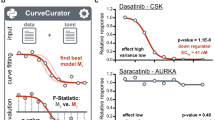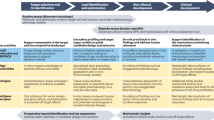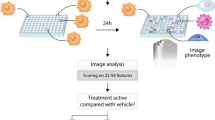Abstract
Acting on reports in the late 1980s that most drug candidates fail in development, pharmaceutical discovery programmes responded by devising ways to increase the number of chemicals in the pipeline. With discovery now driven primarily by chemistry and high-throughput screening, the biological effects and, in particular, the toxicity of new compounds are largely not appreciated until a compound enters development. Arguably, this paradigm has produced more failures rather than delivering more successes — with more chemicals to examine, much less is known about any single agent before costly development studies are initiated. The emerging field of toxicogenomics is enabling us to ask detailed questions about drug effects very early on, thereby fundamentally changing our approach to drug discovery.
This is a preview of subscription content, access via your institution
Access options
Subscribe to this journal
Receive 12 print issues and online access
$209.00 per year
only $17.42 per issue
Buy this article
- Purchase on Springer Link
- Instant access to full article PDF
Prices may be subject to local taxes which are calculated during checkout



Similar content being viewed by others
References
Prentis, R. A., Lis, Y. & Walker, S. R. Pharmaceutical innovation by the seven UK-owned pharmaceutical companies (1964–1985). Br. J. Clin. Pharmacol. 25, 387–396 (1988)
Venkatesh, S. & Lipper, R. A. Role of the development scientist in compound lead selection and optimization. J. Pharm. Sci. 89, 145–154 (2000)
Schena, M., Shalon, D., Davis, R. W. & Brown, P.O. Quantitative monitoring of gene expression patterns with a complementary DNA microarray. Science 270, 467–470 (1995)
Lockhart, D. J. et al. Expression monitoring by hybridization to high-density oligonucleotide arrays. Nature Biotechnol. 14, 1675–1680 (1996)
Lockhart, D. J. & Winzeler, E.A. Genomics, gene expression and DNA arrays. Nature 405, S827–S836 (2000)
Hughes, T. R. et al. Functional discovery via a compendium of expression profiles. Cell 102, 109–126 (2000)
Bartosiewicz, M., Penn, S. & Buckpitt, A. Applications of gene arrays in environmental toxicology: fingerprints of gene regulation associated with cadmium chloride, benzo(a)pyrene, and trichloroethylene. Environ. Health Perspect. 109, 71–74 (2001)
Bartosiewicz, M. J., Jenkins, D., Penn, S., Emery, J. & Buckpitt, A. Unique gene expression patterns in liver and kidney associated with exposure to chemical toxicants. J. Pharmacol. Exp. Ther. 297, 895–905 (2001)
Bulera, S. J. et al. RNA expression in the early characterization of hepatotoxicants in Wistar rats by high-density DNA microarrays. Hepatology 33, 1239–1258 (2001)
Cunningham, M. J., Liang, S., Fuhrman, S., Seilhamer, J. J. & Somogyi, R. Gene expression microarray data analysis for toxicology profiling. Ann. NY Acad. Sci. 919, 52–67 (2000)
Pennie, W. D., Woodyatt, N. J., Aldridge, T. C. & Orphanides, G. Application of genomics to the definition of the molecular basis for toxicity. Toxicol Lett. 31, 353–358 (2001)
Reilly, T. P. et al. Expression profiling of acetaminophen liver toxicity in mice using microarray technology. Biochem. Biophys. Res. Commun. 282, 321–328 (2001)
Rockett, J. C. et al. Development of a 950-gene DNA array for examining gene expression patterns in mouse testis. Genome Biol. (2000). [http://genomebiology.com/2001/2/4/research/0014/]
Waring, J. et al. Clustering of hepatotoxins based on mechanism of toxicity using gene expression profiles. Toxicol. Appl. Pharmacol. 175, 28–42 (2001)
Burczynski, M. E. et al. Toxicogenomics-based discrimination of toxic mechanism in HepG2 human hepatoma cells. Toxicol. Sci. 58, 399–415 (2000)
Waring, J. F., Ciurlionis, R., Jolly, R. A., Heindel, M. & Ulrich, R. G. Microarray analysis of hepatotoxins in vitro reveals a correlation between gene expression profiles and mechanisms of toxicity. Toxicol. Lett. 120, 359–368 (2001)
Quackenbush, J. Computational analysis of microarray data. Nature Rev. Genet. 2, 418–427 (2001)
Gupta, S., Husser, R. C., Geske, R. S., Welty, S. E. & Smith, C. V. Sex differences in diquat-induced hepatic necrosis and DNA fragmentation in Fischer 344 rats. Toxicol. Sci. 54, 203–211 (2000)
Benigni, R. et al. Mutational studies with diquat and paraquat in vitro. Mutat. Res. 68, 183–193 (1979)
Gasch, A. P. et al. Genomic expression responses to DNA-damaging agents and the regulatory role of the yeast ATR homolog Mec1p. Mol. Biol. Cell 12, 2987–3003 (2001)
Thomas, R. S. et al. Identification of toxicologically predictive gene sets using cDNA microarrays. Mol. Pharmacol. 60, 1189–1194 (2001)
Waring, J. R. et al. Identifying toxic mechanisms using DNA microarrays: evidence that an experimental inhibitor of cell adhesion molecule expression signals through the aryl hydrocarbon nuclear receptor. Toxicology (in the press)
Zielinski, N. P. et al. Expression profiling using DNA microarrays reveals a functional antagonism of the peroxisome proliferator activated receptor-α by the protease inhibitor, ritonavir. Abstr. 41st Interscience Conference Antimicrob. Agents Chemother. 229, (American Society for Microbiology, Washington, 2001).
Gerhold, D. et al. Monitoring expression of genes involved in drug metabolism and toxicology using DNA microarrays. Physiol. Genomics 5, 161–170 (2001)
Stratowa, C. et al. cDNA microarray gene expression analysis of B-cell chronic lymphocytic leukemia proposes potential new prognostic markers involved in lymphocyte trafficking. Int. J. Cancer 91, 474–480 (2001)
Acknowledgements
This work could not have been done without the expert help at Rosetta of C. Roberts and the Guided Solutions Team, R. Stoughton and the Informatics team, P. Linsley and the Advanced Solutions team and D. Kessler and the High-Throughput Hybridization Facility, and the team at North Creek, Washington. Rosetta Inpharmatics is a wholly-owned subsidiary of Merck & Co.
Author information
Authors and Affiliations
Related links
Related links
DATABASES
FURTHER INFORMATION
International Life Sciences Institute
Rights and permissions
About this article
Cite this article
Ulrich, R., Friend, S. Toxicogenomics and drug discovery: will new technologies help us produce better drugs?. Nat Rev Drug Discov 1, 84–88 (2002). https://doi.org/10.1038/nrd710
Issue Date:
DOI: https://doi.org/10.1038/nrd710
This article is cited by
-
A Predictive Model for Toxicity Effects Assessment of Biotransformed Hepatic Drugs Using Iterative Sampling Method
Scientific Reports (2016)
-
Emerging technologies and challenges for better and safer drugs
Biotechnology Letters (2014)
-
Mechanisms of amiodarone and valproic acid induced liver steatosis in mouse in vivo act as a template for other hepatotoxicity models
Archives of Toxicology (2014)
-
Proteomic analysis of dimethoate-responsive proteins in the oyster (Saccostrea cucullata) gonad
Environmental Science and Pollution Research (2012)
-
Recent progress in toxicogenomics research in South Korea
BMC Proceedings (2009)



